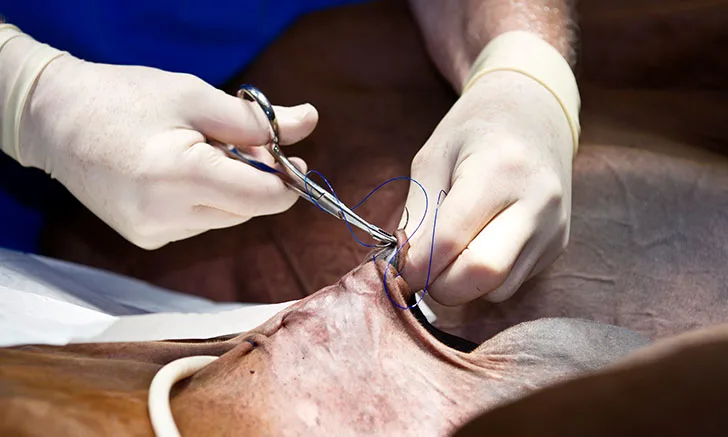Top 5 Considerations for Suture Selection

Sponsored by Arthrex Vet Systems
Suture selection is an important contributor to the success or failure of surgical procedures in veterinary medicine.1 With such a wide variety of suture choices available, understanding what features impact surgical success is key to making the best selection. Explore these 5 considerations when making suture choices in practice.
1. Suture Material Properties
Sutures have many properties to consider, and veterinarians must choose suture types that reflect the surgeries they will be performing. Key properties include size, flexibility, memory, surface characteristics and coating, absorbability, capillarity, knot tensile strength, and relative knot security.2,3
Size and absorbability are 2 commonly considered factors, both of which are key to ensuring effective performance. For example, a larger suture would be used for a procedure in an adult dog as compared with the suture when spaying a kitten. In addition, some tissues may require a suture with slower absorbability, such as rapidly healing skin versus slower healing fascia.3 Having a variety of suture options on hand is critical in the practice setting to ensure options for both frequently performed procedures as well as those that may arise unexpectedly.
2. Ease of Use
An often-overlooked factor for suture selection is the ease of use for the surgeon. For example, needle color should be considered, as silver needles reflect more light and are less visible than black needles.4 VetSuture needles by Arthrex are German precision-engineered needles that are all black to minimize glare and enhance visibility.5
Suture memory (ie, the inherent tendency of a suture to return to its original shape) can also impact the ease of use. For example, monofilament sutures have higher memory as compared with multifilament sutures.6 Higher suture memory not only makes the suture more difficult to use but also makes it more prone to knot-loosening.6 Although memory is often determined by a suture’s properties, some suture types have a specialized plastic labyrinth or craft board design to reduce memory.5
3. Trauma to Patient
Suturing causes tissue trauma, and suture types vary in their effects on wound healing and the potential for causing tissue reactions. For example, a suture of a larger size with slower absorbency would increase tissue trauma and foreign material within the tissue.2
Needle type also impacts the degree of trauma to local tissues during suturing. For example, some suture types require an eyed needle for skin closure, which increases tissue trauma.7 Carefully weighing the pros and cons of these suture features can help the surgeon make the best selection for the patient.
4. Packaging Features
Veterinarians should choose a suture package that is easily identifiable when opened in the sterile field, with the suture size and properties clearly labeled on the outer surface of the suture tray. Selecting a suture package that secures all needles to avoid accidental needle sticks is also an important packaging feature to ensure safety. In addition, VetSuture’s racetrack packaging is specifically designed to mitigate memory in the suture. VetSuture packaging offers these benefits and is also packaged in a suture tray that is recyclable, offering an environmentally friendly option.5
5. Cost Considerations
The relative cost of materials used during surgeries is important to consider and is a key factor in determining surgical fees.1 In a situation with 2 bioequivalent suture materials, cost may be the consideration that causes the veterinarian to choose one suture type over another for their practice.
Conclusion
Choosing a suture that is appropriate for the individual practice, patient, and procedure is key to ensuring successful surgical outcomes. VetSuture by Arthrex offers a variety of sutures that are made with the patient and practitioner in mind, featuring needles designed to reduce drag, allow for easier penetration, resist bending, and provide excellent visibility to the surgeon; they also come in a variety of options, fulfilling the needs of general practitioners who often face a multitude of different surgical procedures in practice.8
